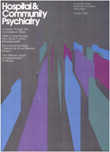Response Strategies for Chart Requests From Psychiatric Inpatients
Abstract
Of 452 patients seen during one year on a medical-school-affiliated general hospital psychiatric unit, 26 requested to see their charts. These patients tended to be younger, more likely to have character disorders, and less likely to have an affective disorder than patients who did not make chart requests. The apparent increase in the number of patients who ask to see their records may be linked to increasing medical consumerism. Rather than causing therapists to become defensive, record requests should provide an opportunity for education and treatment. The authors outline methods of interpreting and responding to chart requests.
Access content
To read the fulltext, please use one of the options below to sign in or purchase access.- Personal login
- Institutional Login
- Sign in via OpenAthens
- Register for access
-
Please login/register if you wish to pair your device and check access availability.
Not a subscriber?
PsychiatryOnline subscription options offer access to the DSM-5 library, books, journals, CME, and patient resources. This all-in-one virtual library provides psychiatrists and mental health professionals with key resources for diagnosis, treatment, research, and professional development.
Need more help? PsychiatryOnline Customer Service may be reached by emailing [email protected] or by calling 800-368-5777 (in the U.S.) or 703-907-7322 (outside the U.S.).



